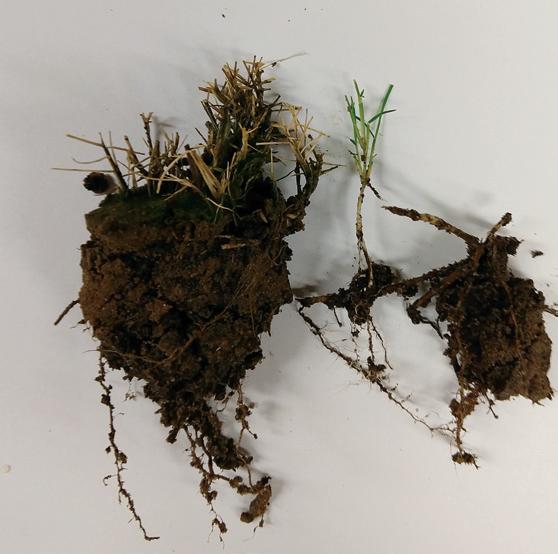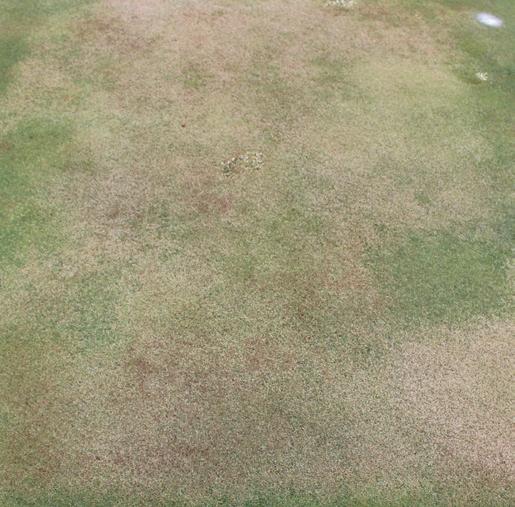
5 minute read
Weed Science Research Update
Pylex – A new Carotenoid Inhibiting Herbicide
By Clebson G. Gonçalves, Ph.D., Graduate Student at Auburn University and Scott McElroy, Ph.D., Professor, Auburn University
Advertisement
Tenacity (mesotrione) was the first carotenoid-inhibiting herbicide introduced to the turfgrass market. It has developed into a niche herbicide due to the need for repeat applications and potential for bleaching green tissue to a white color, even in tolerant species. Despite these issues, it still remains a viable weed control option, especially in cool-season grasses and centipedegrass.
Carotenoids are lipid soluble pigments integrated into light-harvesting complexes (LHC) along with chlorophyll and perform physiological roles of photoprotection and lightharvesting. Photoprotection is the prevention of oxidative damage, or photoinhibition, to the LHC, allowing plants to maintain efficient rates of photosynthesis. Carotenoids function as photoprotectants by sequestering free radicals before oxidative damage can occur to the chlorophyll and the larger LHC. Carotenoids function as light-harvesting pigments by channeling photons unabsorbed by the chlorophyll molecule to the reaction center for photosynthesis. Thus, two things happen when carotenoids are inhibited — the LHC is destroyed due to light stress and light is not channeled to the chlorophyll for photosynthesis.
Pylex (Topramezone) is a new postemergence herbicide that controls susceptible species by inhibiting carotenoid biosynthesis; specifically, it inhibits the enzyme p-hydroxyphenylpyruvate dioxygenase (HPPD) (Shaner, 2014). Topramezone (Pylex) is labeled for use in turfgrasses for the control of both grass and broadleaf weeds (Anonymous 2006; Smith et al., 2013). The characteristic symptoms of susceptible weeds by HPPD inhibitors is bleaching because of chlorophyll loss.
Weed management
Pylex has become an important tool in turfgrass systems as it effectively controls crabgrass species (Digitaria spp.) and goosegrass [Eleusine indica (L.) Gaertn.] with a low application rate of 12.3 to 36.8 g ai ha -1 .
Among the HPPD inhibitors, sequential applications of Pylex have potential for bermudagrass suppression (Brosnan et al. 2011). However, researchers showed that Pylex alone cannot effectively control bermudagrass, suggesting that tank mixtures with other herbicides may be required to provide effective long-term control.
Previous research shows that Pylex combined with triclopyr (Turflon Ester) may be used for bermudagrass control (Brosnan and Breeden 2013; McElroy and Breeden 2006). Researchers at Auburn University seek to determine better Pylex plus Turflon Ester rates for bermudagrass control. The first results showed that Pylex in combination with Turflon Ester provided an increase in bermudagrass control compared to Pylex alone, and reduced visual bleaching. This effect would be beneficial since it is always desired to control weeds with minimal reduction of turf aesthetics and quality from the strong bleaching effects of Pylex.
Although Pylex in combination with triclopyr has provided excellent control of bermudagrass, this species is very aggressive and has a high capacity for new infestation by the regenerative underground organs, so reapplication is required for long-term control (Figure 1).

Figure 1

Figure 1
Pylex Application
Pylex is registered for use in most cool-season turfgrasses such as fescue (Festuca sp.), bluegrass (Poa sp.), bluestem (Andropogon sp.), and centipedegrass (Eremochloa sp.) (Haller et al., 2017). Although creeping bentgrass injuries caused by Pylex have been reported (Elmore et al., 2015), reduced rates can reduce injury, opening the door for possible future use of Pylex. Creeping bentgrass injury can be influenced by different factors such as application rate, tank mixes, growing season, soil/air temperature, precipitation, and other environment conditions. The specifics of such factors remain poorly understood.
Turfgrass managers have commonly used low Pylex application rates (<0.5 fl oz/a) and re-applied (weekly or every two weeks) to control crabgrass and goosegrass. This strategy aims to decrease bleaching injuries in creeping bentgrass.
Currently, studies at Auburn University have investigated the optimal growing season for Pylex application and also the integration of field programs with paclobutrazol (Trimmit 2SC), Fe chelate (Sprint 330) or a turfgrass pigment (Sarge 2.0) to reduce bleaching injuries (Figure 2).

Figure 2: April Application

Figure 2: May Application

Figure 2: June Application

Figure 2: July Application
Pylex applications exhibited ever increasing injury to creeping bentgrass from April to July, likely due to increasing temperatures that stressed the turfgrass during this period. In general, combination with paclobutrazol, Fe chelate, or turfgrass pigment reduced visual turfgrass injuries compared to topramezone applied alone. Treatments that included paclobutrazol application programs were the most efficient because it increased turfgrass quality and reduced bleaching injuries caused by topramezone. The next step in this research is determining if those field programs could reduce injury from Pylex without reducing weed control (Figure 3).

Figure 3: Left to Right: Topramezone, Topramezone + Paclobutrazol and Non-treated
Future Research
Neither Tenacity or Pylex are simple straightforward herbicides to use. Both provide unique benefits to turfgrass weed control needs. Research is continuing at Auburn to discover how to use this unique mode of action in ways that improve herbicide safety to desirable turf and increase weed control. We are hopeful that both Pylex and Tenacity will help provide an additional mode of action in the age of growing herbicide resistance to traditional chemistry.
References
Anonymous. 2006. Impact herbicide label. 11926-3. Los Angeles, CA: AMVAC.
Brosnan J.T. and Breeden G.K. 2013. Bermudagrass (Cynodon dactylon) control with topramezone and triclopyr. Weed Technology, 27:138-142.
Brosnan J.T., D.A. Kopsell, M.T. Elmore, G.K. Breeden and G.R. Armel. 2011. Changes in ‘Riviera’bermudagrass [Cynodon dactylon (L.) Pers.] carotenoid pigments after treatment with three p-hydroxyphenylpyruvate dioxygenase-inhibiting herbicides. HortScience, 46:493-498.
Elmore, M.T., J.T. Brosnan, G.R. Armel, D.A. Kopsell, M.D. Best, T.C. Mueller and Sorochan, J.C. 2015. Cytochrome P450 inhibitors reduce creeping bentgrass (Agrostis stolonifera) tolerance to topramezone. PLOS one, 10:e0130947.
Haller, W. T., L.A. Gettys and T. Uchida. 2017. Effects of topramezone and bispyribac-sodium in irrigation water on warm-season turfgrasses. HortTechnology, 27:599-606.
McElroy J.S. and G.K. Breeden. 2006. Triclopyr safens the use of fluazifop and fenoxaprop on zoysiagrass while maintaining bermudagrass suppression. Applied Turfgrass Science, 3:0-0.
Shaner D.L. ed. 2014. Herbicide Handbook. 10th edn, Lawrence, KS: Weed Science Society of America. Pp 449–450
Smith A., M. Cox, S.D. Askew and K. Miller. 2013. Topramezone for crabgrass and goosegrass control in cool season turf. Proc Southern Weed Sci Soc. 66: 3.






